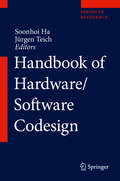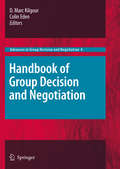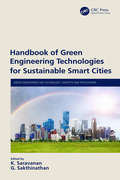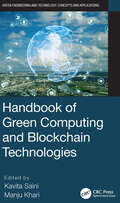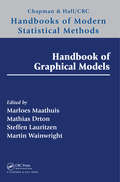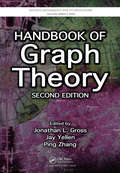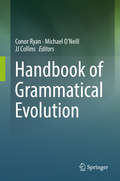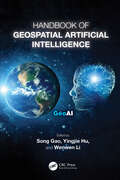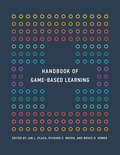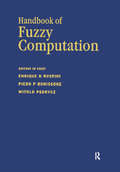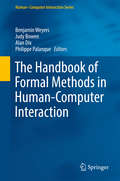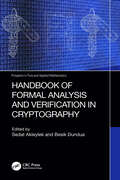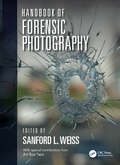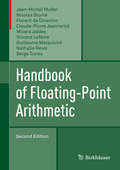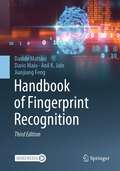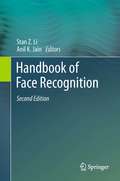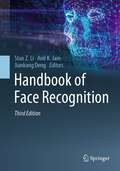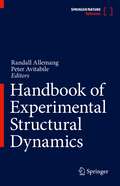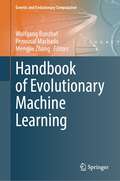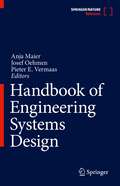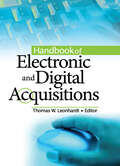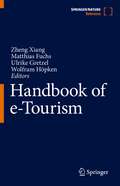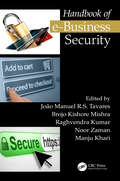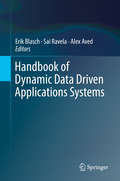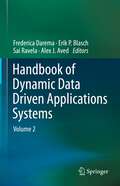- Table View
- List View
Handbook of Hardware/Software Codesign
by Soonhoi Ha Jürgen TeichThis handbook presents fundamental knowledge on the hardware/software (HW/SW) codesign methodology. Contributing expert authors look at key techniques in the design flow as well as selected codesign tools and design environments, building on basic knowledge to consider the latest techniques. The book enables readers to gain real benefits from the HW/SW codesign methodology through explanations and case studies which demonstrate its usefulness. Readers are invited to follow the progress of design techniques through this work, which assists readers in following current research directions and learning about state-of-the-art techniques. Students and researchers will appreciate the wide spectrum of subjects that belong to the design methodology from this handbook.
Handbook of Group Decision and Negotiation
by D. Marc Kilgour Colin EdenThe field of Group Decision and Negotiation can be described as the empirical, formal, computational, and strategic analysis of group decision-making and negotiation, especially from the points of view of Management Science and Operations Research. Group Decision and Negotiation crosses many traditional disciplinary boundaries, and has connections to business administration and business strategy, management science, systems engineering, computer science, mathematics, and law, as well as economics, psychology, and other social sciences. The Handbook of Group Decision and Negotiation is intended to become the major reference in the field. The only current references are the highly successful journal Group Decision and Negotiation, as well as the books of the Advances in Group Decision and Negotiation series, and a few other journals. Researchers, students, and practitioners in this growing field sorely need a good general reference.
Handbook of Green Engineering Technologies for Sustainable Smart Cities (Green Engineering and Technology)
by K. Saravanan; G. SakthinathanHandbook of Green Engineering Technologies for Sustainable Smart Cities focuses on the complete exploration and presentation of green smart city applications, techniques, and architectural frameworks. It provides detailed coverage of urban sustainability spanning across various engineering disciplines. The book discusses and explores green engineering technologies for smart cities and covers various engineering disciplines and environmental science. It emphasizes techniques, application frameworks, tools, and case studies. All chapters play a part in the evolution of sustainable green smart cities and present how to solve environmental issues by applying modern industrial IoT solutions. This book will benefit researchers, smart city practitioners, academicians, university students, and policy makers.
Handbook of Green Computing and Blockchain Technologies (Green Engineering and Technology)
by Kavita Saini Manju KhariThis handbook provides a computational perspective on green computing and blockchain technologies. It presents not only how to identify challenges using a practical approach but also how to develop strategies for addressing industry challenges. Handbook of Green Computing and Blockchain Technologies takes a practical-oriented approach, including solved examples and highlights standardization, industry bodies, and initiatives. Case studies provide a deeper understanding of blockchain and are related to real-time scenarios. The handbook analyzes current research and development in green computing and blockchain analytics, studies existing related standards and technologies, and provides results on implementation, challenges, and issues in today’s society. FEATURES Analyzes current research developments in green computing and blockchain analytics Provides an analysis of implementation challenges and solutions Offers innovations in the decentralization process for the application of blockchain in areas such as healthcare, government services, agriculture, supply chain, financial, ecommerce, and more Discusses the impact of this technology on people’s lives, the way they work and learn, and highlights standardization, industry bodies, and initiatives This handbook will benefit researchers, software developers, and undergraduate and postgraduate students in industrial systems, manufacturing, information technology, computer science, manufacturing, communications, and electrical engineering.
Handbook of Graphical Models (Chapman & Hall/CRC Handbooks of Modern Statistical Methods)
by Marloes Maathuis Mathias Drton Steffen Lauritzen Martin WainwrightA graphical model is a statistical model that is represented by a graph. The factorization properties underlying graphical models facilitate tractable computation with multivariate distributions, making the models a valuable tool with a plethora of applications. Furthermore, directed graphical models allow intuitive causal interpretations and have become a cornerstone for causal inference. While there exist a number of excellent books on graphical models, the field has grown so much that individual authors can hardly cover its entire scope. Moreover, the field is interdisciplinary by nature. Through chapters by leading researchers from different areas, this handbook provides a broad and accessible overview of the state of the art. Key features: * Contributions by leading researchers from a range of disciplines * Structured in five parts, covering foundations, computational aspects, statistical inference, causal inference, and applications * Balanced coverage of concepts, theory, methods, examples, and applications * Chapters can be read mostly independently, while cross-references highlight connections The handbook is targeted at a wide audience, including graduate students, applied researchers, and experts in graphical models.
Handbook of Graph Theory (Discrete Mathematics And Its Applications Ser.)
by Jonathan L. Gross Jay Yellen Ping ZhangIn the ten years since the publication of the best-selling first edition, more than 1,000 graph theory papers have been published each year. Reflecting these advances, Handbook of Graph Theory, Second Edition provides comprehensive coverage of the main topics in pure and applied graph theory. This second edition-over 400 pages longer than its prede
Handbook of Grammatical Evolution
by Conor Ryan Michael O'Neill Jj CollinsThis handbook offers a comprehensive treatise on Grammatical Evolution (GE), a grammar-based Evolutionary Algorithm that employs a function to map binary strings into higher-level structures such as programs. GE's simplicity and modular nature make it a very flexible tool. Since its introduction almost twenty years ago, researchers have applied it to a vast range of problem domains, including financial modelling, parallel programming and genetics. Similarly, much work has been conducted to exploit and understand the nature of its mapping scheme, triggering additional research on everything from different grammars to alternative mappers to initialization. The book first introduces GE to the novice, providing a thorough description of GE along with historical key advances. Two sections follow, each composed of chapters from international leading researchers in the field. The first section concentrates on analysis of GE and its operation, giving valuable insight into set up and deployment. The second section consists of seven chapters describing radically different applications of GE. The contributions in this volume are beneficial to both novices and experts alike, as they detail the results and researcher experiences of applying GE to large scale and difficult problems. Topics include: • Grammar design • Bias in GE • Mapping in GE • Theory of disruption in GE · Structured GE · Geometric semantic GE · GE and semantics · Multi- and Many-core heterogeneous parallel GE · Comparing methods to creating constants in GE · Financial modelling with GE · Synthesis of parallel programs on multi-cores · Design, architecture and engineering with GE · Computational creativity and GE · GE in the prediction of glucose for diabetes · GE approaches to bioinformatics and system genomics · GE with coevolutionary algorithms in cybersecurity · Evolving behaviour trees with GE for platform games · Business analytics and GE for the prediction of patient recruitment in multicentre clinical trials
Handbook of Geospatial Artificial Intelligence
by Song Gao Yingjie Hu Wenwen LiThis comprehensive handbook covers Geospatial Artificial Intelligence (GeoAI), which is the integration of geospatial studies and AI machine (deep) learning and knowledge graph technologies. It explains key fundamental concepts, methods, models, and technologies of GeoAI, and discusses the recent advances, research tools, and applications that range from environmental observation and social sensing to natural disaster responses. As the first single volume on this fast-emerging domain, Handbook of Geospatial Artificial Intelligence is an excellent resource for educators, students, researchers, and practitioners utilizing GeoAI in fields such as information science, environment and natural resources, geosciences, and geography. Features Provides systematic introductions and discussions of GeoAI theory, methods, technologies, applications, and future perspectives Covers a wide range of GeoAI applications and case studies in practice Offers supplementary materials such as data, programming code, tools, and case studies Discusses the recent developments of GeoAI methods and tools Includes contributions written by top experts in cutting-edge GeoAI topics This book is intended for upper-level undergraduate and graduate students from different disciplines and those taking GIS courses in geography or computer sciences as well as software engineers, geospatial industry engineers, GIS professionals in non-governmental organizations, and federal/state agencies who use GIS and want to learn more about GeoAI advances and applications.
Handbook of Game-Based Learning (The\mit Press Ser.)
by Jan L. Plass Richard E. Mayer Bruce D. HomerA comprehensive introduction to the latest research and theory on learning and instruction with computer games.This book offers a comprehensive introduction to the latest research on learning and instruction with computer games. Unlike other books on the topic, which emphasize game development or best practices, Handbook of Game-Based Learning is based on empirical findings and grounded in psychological and learning sciences theory. The contributors, all leading researchers in the field, offer a range of perspectives, including cognitive, motivational, affective, and sociocultural. They explore research on whether (and how) computer games can help students learn educational content and academic skills; which game features (including feedback, incentives, adaptivity, narrative theme, and game mechanics) can improve the instructional effectiveness of these games; and applications, including games for learning in STEM disciplines, for training cognitive skills, for workforce learning, and for assessment. The Handbook offers an indispensable reference both for readers with practical interests in designing or selecting effective game-based learning environments and for scholars who conduct or evaluate research in the field. It can also be used in courses related to play, cognition, motivation, affect, instruction, and technology.ContributorsRoger Azevedo, Ryan S. Baker, Daphne Bavelier, Amanda E. Bradbury, Ruth C. Clark, Michele D. Dickey, Hamadi Henderson, Bruce D. Homer, Fengfeng Ke, Younsu Kim, Charles E. Kinzer, Eric Klopfer, James C. Lester, Kristina Loderer, Richard E. Mayer, Bradford W. Mott, Nicholas V. Mudrick, Brian Nelson, Frank Nguyen, V. Elizabeth Owen, Shashank Pawar, Reinhard Pekrun, Jan L. Plass, Charles Raffale, Jonathon Reinhardt, C. Scott Rigby, Jonathan P. Rowe, Richard M. Ryan, Ruth N. Schwartz, Quinnipiac Valerie J. Shute, Randall D. Spain, Constance Steinkuehler, Frankie Tam, Michelle Taub, Meredith Thompson, Steven L. Thorne, A. M. Tsaasan
Handbook of Fuzzy Computation
by Enrique H Ruspini; Piero P Bonissone; Witold PedryczInitially conceived as a methodology for the representation and manipulation of imprecise and vague information, fuzzy computation has found wide use in problems that fall well beyond its originally intended scope of application. Many scientists and engineers now use the paradigms of fuzzy computation to tackle problems that are either intractable
The Handbook of Formal Methods in Human-Computer Interaction
by Benjamin Weyers Judy Bowen Alan Dix Philippe PalanqueThis book provides a comprehensive collection of methods and approaches for using formal methods within Human-Computer Interaction (HCI) research, the use of which is a prerequisite for usability and user-experience (UX) when engineering interactive systems. World-leading researchers present methods, tools and techniques to design and develop reliable interactive systems, offering an extensive discussion of the current state-of-the-art with case studies which highlight relevant scenarios and topics in HCI as well as presenting current trends and gaps in research and future opportunities and developments within this emerging field. The Handbook of Formal Methods in Human-Computer Interaction is intended for HCI researchers and engineers of interactive systems interested in facilitating formal methods into their research or practical work.
Handbook of Formal Analysis and Verification in Cryptography (Prospects in Pure and Applied Mathematics)
by Sedat Akleylek Besik DunduaThis handbook of formal analysis in cryptography is very important for secure communication and processing of information. It introduces readers to several formal verification methods and software used to analyse cryptographic protocols. The chapters give readers general knowledge and formal methods focusing on cryptographic protocols. Handbook of Formal Analysis and Verification in Cryptography includes major formalisms and tools used for formal verification of cryptography, with a spotlight on new-generation cryptosystems such as post-quantum, and presents a connection between formal analysis and cryptographic schemes. The text offers formal methods to show whether security assumptions are valid and compares the most prominent formalism and tools as they outline common challenges and future research directions. Graduate students, researchers, and engineers worldwide will find this an exciting read.
Handbook of Forensic Photography
by Sanford L WeissHandbook of Forensic Photography is the most-comprehensive, definitive reference for the use of photography in the capture and presentation of forensic evidence. The intent is to inform the reader about the most complete and up-to-date methods to capture and reproduce images that most accurately represent the evidence. With the rise in importance of forensic science, crime and accident scene documentation has likewise increased in importance—not the least of which has been forensic photography. The need to use accepted practice and protocols to guarantee the authenticity of images for evidence documentation is paramount for using it in court. And as with any discipline, there is an art to the science of forensic photography. Contributing authors from various backgrounds—each experts in their field—have provided numerous case examples, best practices, and recommendations for recognizing, recording, and preserving evidence using cameras and the latest digital image technology, including video and other imaging technologies. Chapters present such topics as videography, drone photography, underwater photography, crime scene photography, autopsy photographs, fire documentation, forensic odontology, and more. The book closes with coverage of courtroom displays, presenting imaging evidence and expert witness testimony in the courtroom. Handbook of Forensic Photography is a must-have reference for experienced crime scene photographers, death and crime scene investigators, police, and forensic professionals—including medical examiners, odontologists, engineers, and forensic anthropologists—who frequently need to capture investigative photographs in the course of investigations.
Handbook of Floating-Point Arithmetic
by Serge Torres Nathalie Revol Guillaume Melquiond Vincent Lefèvre Mioara Joldes Claude-Pierre Jeannerod Florent De Dinechin Nicolas Brunie Jean-Michel MullerFloating-point arithmetic is the most widely used way of implementing real-number arithmetic on modern computers. However, making such an arithmetic reliable and portable, yet fast, is a very difficult task. As a result, floating-point arithmetic is far from being exploited to its full potential. This handbook aims to provide a complete overview of modern floating-point arithmetic. So that the techniques presented can be put directly into practice in actual coding or design, they are illustrated, whenever possible, by a corresponding program. The handbook is designed for programmers of numerical applications, compiler designers, programmers of floating-point algorithms, designers of arithmetic operators, and more generally, students and researchers in numerical analysis who wish to better understand a tool used in their daily work and research.
Handbook of Fingerprint Recognition
by Anil K. Jain Jianjiang Feng Davide Maltoni Dario MaioA major new professional reference work on fingerprint security systems and technology from leading international researchers in the field. Handbook provides authoritative and comprehensive coverage of all major topics, concepts, and methods for fingerprint security systems. This unique reference work is an absolutely essential resource for all biometric security professionals, researchers, and systems administrators.
Handbook of Face Recognition
by Stan Z. Li Anil K. JainThis highly anticipated new edition provides a comprehensive account of face recognition research and technology, spanning the full range of topics needed for designing operational face recognition systems. After a thorough introductory chapter, each of the following chapters focus on a specific topic, reviewing background information, up-to-date techniques, and recent results, as well as offering challenges and future directions. Features: fully updated, revised and expanded, covering the entire spectrum of concepts, methods, and algorithms for automated face detection and recognition systems; provides comprehensive coverage of face detection, tracking, alignment, feature extraction, and recognition technologies, and issues in evaluation, systems, security, and applications; contains numerous step-by-step algorithms; describes a broad range of applications; presents contributions from an international selection of experts; integrates numerous supporting graphs, tables, charts, and performance data.
Handbook of Face Recognition
by Stan Z. Li Anil K. Jain Jiankang DengThe history of computer-aided face recognition dates to the 1960s, yet the problem of automatic face recognition – a task that humans perform routinely and effortlessly in our daily lives – still poses great challenges, especially in unconstrained conditions.This highly anticipated new edition provides a comprehensive account of face recognition research and technology, spanning the full range of topics needed for designing operational recognition systems. After a thorough introduction, each subsequent chapter focuses on a specific topic, reviewing background information, up-to-date techniques, and recent results, as well as offering challenges and future directions.Topics and features:Fully updated, revised, and expanded, covering the entire spectrum of concepts, methods, and algorithms for automated detection and recognition systemsProvides comprehensive coverage of face detection, alignment, feature extraction, and recognition technologies, and issues in evaluation, systems, security, and applicationsContains numerous step-by-step algorithmsDescribes a broad range of applications from person verification, surveillance, and security, to entertainmentPresents contributions from an international selection of preeminent expertsIntegrates numerous supporting graphs, tables, charts, and performance dataThis practical and authoritative reference is an essential resource for researchers, professionals and students involved in image processing, computer vision, biometrics, security, Internet, mobile devices, human-computer interface, E-services, computer graphics and animation, and the computer game industry.
Handbook of Experimental Structural Dynamics
by Randall Allemang Peter AvitabileThe SEM Handbook of Experimental Structural Dynamics stands as a comprehensive overview and reference for its subject, applicable to workers in research, product design and manufacture, and practice. The Handbook is devoted primarily to the areas of structural mechanics served by the Society for Experimental Mechanics IMAC community, such as modal analysis, rotating machinery, structural health monitoring, shock and vibration, sensors and instrumentation, aeroelasticity, ground testing, finite element techniques, model updating, sensitivity analysis, verification and validation, experimental dynamics sub-structuring, quantification of margin and uncertainty, and testing of civil infrastructure. Chapters offer comprehensive, detailed coverage of decades of scientific and technologic advance and all demonstrate an experimental perspective. Several sections specifically discuss the various types of experimental testing and common practices utilized in the automotive, aerospace, and civil structures industries. · History of Experimental Structural Mechanics · DIC Methods - Dynamic Photogrammetry · LDV Methods · Applied Digital Signal Processing · Introduction to Spectral - Basic Measurements · Structural Measurements - FRF · Random and Shock Testing · Rotating System Analysis Methods · Sensors Signal Conditioning Instrumentation · Design of Modal Tests · Experimental Modal Methods · Experimental Modal Parameter Evaluation · Operating Modal Analysis Methods · Analytical Numerical Substructuring · Finite Element Model Correlation · Model Updating · Damping of Materials and Structures · Model Calibration and Validation in Structures · Uncertainty Quantification: UQ, QMU and Statistics · Nonlinear System Analysis Methods (Experimental) · Structural Health Monitoring and Damage Detection · Experimental Substructure Modeling · Modal Modeling · Response (Impedance) Modeling · Nonlinear Normal Mode Analysis Techniques (Analytical) · Modal Modeling with Nonlinear Connection Elements (Analytical) · Acoustics of Structural Systems (VibroAcoustics) · Automotive Structural Testing · Civil Structural Testing · Aerospace Perspective for Modeling and Validation · Sports Equipment Testing · Applied Math for Exper
Handbook of Evolutionary Machine Learning (Genetic and Evolutionary Computation)
by Wolfgang Banzhaf Penousal Machado Mengjie ZhangThis book, written by leading international researchers of evolutionary approaches to machine learning, explores various ways evolution can address machine learning problems and improve current methods of machine learning. Topics in this book are organized into five parts. The first part introduces some fundamental concepts and overviews of evolutionary approaches to the three different classes of learning employed in machine learning. The second addresses the use of evolutionary computation as a machine learning technique describing methodologic improvements for evolutionary clustering, classification, regression, and ensemble learning. The third part explores the connection between evolution and neural networks, in particular the connection to deep learning, generative and adversarial models as well as the exciting potential of evolution with large language models. The fourth part focuses on the use of evolutionary computation for supporting machine learning methods. This includes methodological developments for evolutionary data preparation, model parametrization, design, and validation. The final part covers several chapters on applications in medicine, robotics, science, finance, and other disciplines. Readers find reviews of application areas and can discover large-scale, real-world applications of evolutionary machine learning to a variety of problem domains. This book will serve as an essential reference for researchers, postgraduate students, practitioners in industry and all those interested in evolutionary approaches to machine learning.
Handbook of Engineering Systems Design
by Anja Maier Josef Oehmen Pieter E. VermaasThis handbook charts the new engineering paradigm of engineering systems. It brings together contributions from leading thinkers in the field and discusses the design, management and enabling policy of engineering systems. It contains explorations of core themes including technical and (socio-) organisational complexity, human behaviour and uncertainty. The text includes chapters on the education of future engineers, the way in which interventions can be designed, and presents a look to the future. This book follows the emergence of engineering systems, a new engineering paradigm that will help solve truly global challenges. This global approach is characterised by complex sociotechnical systems that are now co-dependent and highly integrated both functionally and technically as well as by a realisation that we all share the same: climate, natural resources, a highly integrated economical system and a responsibility for global sustainability goals. The new paradigm and approach requires the (re)designing of engineering systems that take into account the shifting dynamics of human behaviour, the influence of global stakeholders, and the need for system integration. The text is a reference point for scholars, engineers and policy leaders who are interested in broadening their current perspective on engineering systems design and in devising interventions to help shape societal futures.
Handbook of Electronic and Digital Acquisitions
by Thomas W LeonhardtEverything you need to know about adding e-resources to your library's servicesHandbook of Electronic and Digital Acquisitions steers librarians through the process of evaluating, choosing, and managing electronic resources as they expand their collection development policies to include electronic databases. This handy, how-to guide takes a practic
Handbook of e-Tourism
by Zheng Xiang Matthias Fuchs Ulrike Gretzel Wolfram HöpkenThis handbook provides an authoritative and truly comprehensive overview both of the diverse applications of information and communication technologies (ICTs) within the travel and tourism industry and of e-tourism as a field of scientific inquiry that has grown and matured beyond recognition. Leading experts from around the world describe cutting-edge ideas and developments, present key concepts and theories, and discuss the full range of research methods. The coverage accordingly encompasses everything from big data and analytics to psychology, user behavior, online marketing, supply chain and operations management, smart business networks, policy and regulatory issues – and much, much more. The goal is to provide an outstanding reference that summarizes and synthesizes current knowledge and establishes the theoretical and methodological foundations for further study of the role of ICTs in travel and tourism. The handbook will meet the needs of researchers and students in various disciplines as well as industry professionals. As with all volumes in Springer’s Major Reference Works program, readers will benefit from access to a continually updated online version.
Handbook of e-Business Security
by João Manuel Tavares Brojo Kishore Mishra Raghvendra Kumar Noor Zaman Manju KhariThere are a lot of e-business security concerns. Knowing about e-business security issues will likely help overcome them. Keep in mind, companies that have control over their e-business are likely to prosper most. In other words, setting up and maintaining a secure e-business is essential and important to business growth. This book covers state-of-the art practices in e-business security, including privacy, trust, security of transactions, big data, cloud computing, social network, and distributed systems.
Handbook of Dynamic Data Driven Applications Systems
by Erik Blasch Sai Ravela Alex AvedThe Handbook of Dynamic Data Driven Applications Systems establishes an authoritative reference of DDDAS, pioneered by Dr. Darema and the co-authors for researchers and practitioners developing DDDAS technologies.Beginning with general concepts and history of the paradigm, the text provides 32 chapters by leading experts in10 application areas to enable an accurate understanding, analysis, and control of complex systems; be they natural, engineered, or societal:Earth and Space Data AssimilationAircraft Systems ProcessingStructures Health MonitoringBiological Data AssessmentObject and Activity TrackingEmbedded Control and CoordinationEnergy-Aware OptimizationImage and Video ComputingSecurity and Policy CodingSystems Design The authors explain how DDDAS unifies the computational and instrumentation aspects of an application system, extends the notion of Smart Computing to span from the high-end to the real-time data acquisition and control, and manages Big Data exploitation with high-dimensional model coordination.
Handbook of Dynamic Data Driven Applications Systems: Volume 2
by Frederica Darema Erik P. Blasch Sai Ravela Alex J. AvedThis Second Volume in the series Handbook of Dynamic Data Driven Applications Systems (DDDAS) expands the scope of the methods and the application areas presented in the first Volume and aims to provide additional and extended content of the increasing set of science and engineering advances for new capabilities enabled through DDDAS. The methods and examples of breakthroughs presented in the book series capture the DDDAS paradigm and its scientific and technological impact and benefits. The DDDAS paradigm and the ensuing DDDAS-based frameworks for systems’ analysis and design have been shown to engender new and advanced capabilities for understanding, analysis, and management of engineered, natural, and societal systems (“applications systems”), and for the commensurate wide set of scientific and engineering fields and applications, as well as foundational areas. The DDDAS book series aims to be a reference source of many of the important research and development efforts conducted under the rubric of DDDAS, and to also inspire the broader communities of researchers and developers about the potential in their respective areas of interest, of the application and the exploitation of the DDDAS paradigm and the ensuing frameworks, through the examples and case studies presented, either within their own field or other fields of study. As in the first volume, the chapters in this book reflect research work conducted over the years starting in the 1990’s to the present. Here, the theory and application content are considered for:Foundational MethodsMaterials SystemsStructural SystemsEnergy SystemsEnvironmental Systems: Domain Assessment & Adverse Conditions/WildfiresSurveillance SystemsSpace Awareness SystemsHealthcare SystemsDecision Support SystemsCyber Security SystemsDesign of Computer Systems The readers of this book series will benefit from DDDAS theory advances such as object estimation, information fusion, and sensor management. The increased interest in Artificial Intelligence (AI), Machine Learning and Neural Networks (NN) provides opportunities for DDDAS-based methods to show the key role DDDAS plays in enabling AI capabilities; address challenges that ML-alone does not, and also show how ML in combination with DDDAS-based methods can deliver the advanced capabilities sought; likewise, infusion of DDDAS-like approaches in NN-methods strengthens such methods. Moreover, the “DDDAS-based Digital Twin” or “Dynamic Digital Twin”, goes beyond the traditional DT notion where the model and the physical system are viewed side-by-side in a static way, to a paradigm where the model dynamically interacts with the physical system through its instrumentation, (per the DDDAS feed-back control loop between model and instrumentation).
